Phnom Penh is changing at a breakneck speed. The city feels modern, bustling and full of life. Old buildings are being renovated and new buildings are springing up on every corner. Nonetheless, the bloody and traumatic history of Pol Pot’s Khmer Rouge regime still figures prominently.
The “attractions” that most tourists come to see are the notorious Tuol Sleng Genocide Museum right in Phnom Penh, and the Killing Fields at Choeung Ek, about 14 km. southwest of the city. We wanted to visit both sites before we explored the rest of Phnom Penh, to allow us to put the rest of our visit here into context.
Please be warned: Contents of this posting will be disturbing to all.
Yesterday we visited Tuol Sleng, a former high school that was taken over in 1975 and turned into a prison known as Security Prison 21, or S21. This was the first stop for prisoners; an agonizing hell of interrogation and torture before being shipped off to The Killing Fields to be executed.
The Museum is excellent – dignified and sombre, with signs asking for “Silence”. Tourists are equipped with headsets and an audio account of the grounds, with each stop numbered and the capability to pause and return. We all walked in our own quiet bubbles, listening to gut-wrenching stories and first-person accounts from both survivors and former guards.
This is Building A, where some of the interrogations took place. Each room held a cot, shackles, and in some cases, floor tiles darkened from bloodstains are still visible. A photo of a victim was on each wall. Photos were not allowed.
In front of the building, there are 14 graves. When the Khmer Rouge were defeated, the prison was seized and they discovered 14 bodies that had not yet been moved to The Killing Fields. They are the only victims to have a final resting place with their remains intact.
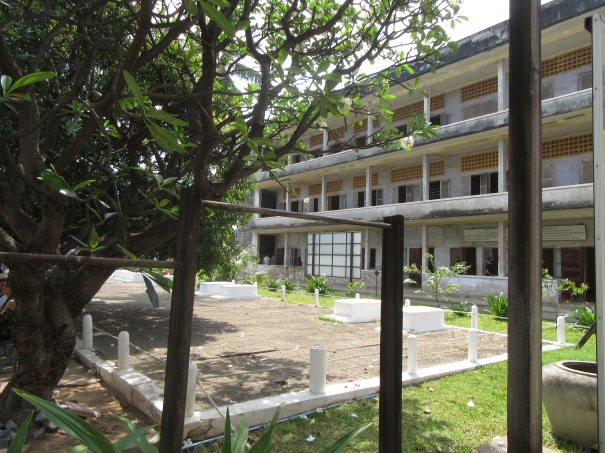
The Security of Regulations. If any of these rules were broken, prisoners would be beaten even more severely.

Prisoners were typically intellectuals, government officials, artists, doctors, teachers, monks – anyone who lived in cities and might have the capacity and intelligence to counter the new regime. The Khmer Rouge wanted to re-structure the society by eliminating education and religion and returning all citizens to an agrarian society.
S-21 became the largest detention centre in Cambodia, and over 100 people a day were tortured, then killed. In total, an estimated 2.5 – 3 million Cambodians were killed, or died of disease or malnutrition during this period – about one-quarter of the population.
Methods of torture were described in great detail. The barbaric imagination of the Khmer Rouge cadres is shocking, impossible to fathom.
This method of interrogation involved tying the victim’s hands behind his back, and hanging him upside down, suspended by his hands from the beam until he passed out.
To revive him, the guards would lower him face-first into the jars on the ground, filled with water and human feces.
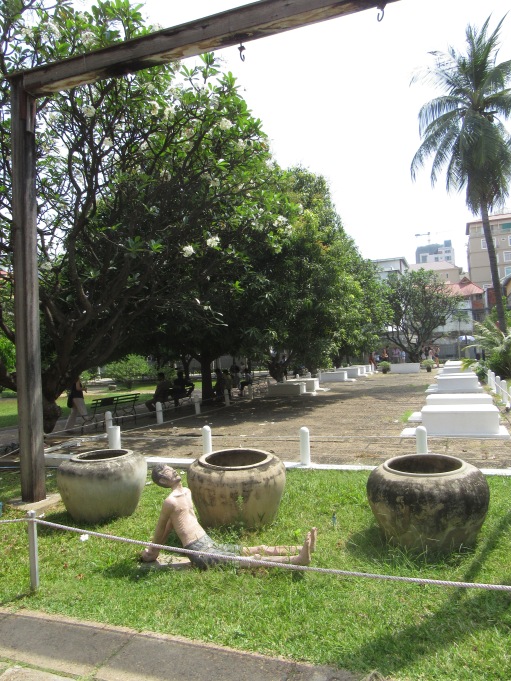
Water tortures were common – dunking victims in ice water and subjecting them to a type of water torture we have all heard about called waterboarding.
Women were subjected to sexual torture, including having centipedes inserted into their vaginas. Their children were often murdered in front of them.
A showcase of the instruments of torture and paintings depicting various torture scenes hang throughout the museum.
Photos were taken of every prisoner, both before and after their torture. I will include a photo of the before shots and spare you the ones taken later.
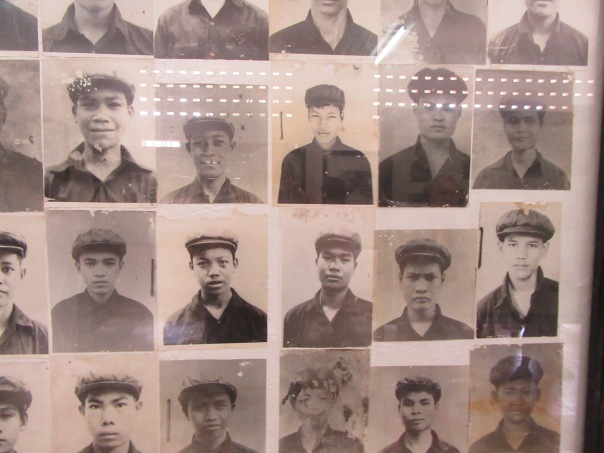
In another building, the Khmer Rouge had punched through old classroom walls and built tiny cells where prisoners were shackled to the floor, with a small metal box for their waste. Photos and biographies of Pol Pot and his head henchmen were displayed, as well as details about past and ongoing trials. None of them have ever admitted to the genocide.
Although the photos and images and words are sickening, the museum is a sacred place. I wondered if it would feel voyeuristic, but it was quite the opposite. The victims and their terrible fates are treated with great respect and the museum and Killing Fields are bearing witness.
The monument in the centre of the grounds is surrounded by granite blocks that contain the names of all the victims that passed through here.
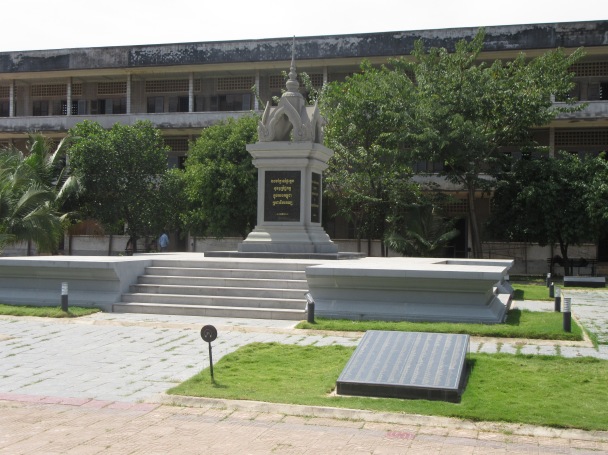
Today we hired a tuk-tuk to drive out to Choeung Ek Genocidal Centre, also known as The Killing Fields. What I didn’t know is that Choeung Ek is the best-known killing field in Cambodia, but not the only one. There are over 300 sites where bodies were disposed of in mass graves or in shallow ponds. The dots on the map indicate where most of the sites are located.
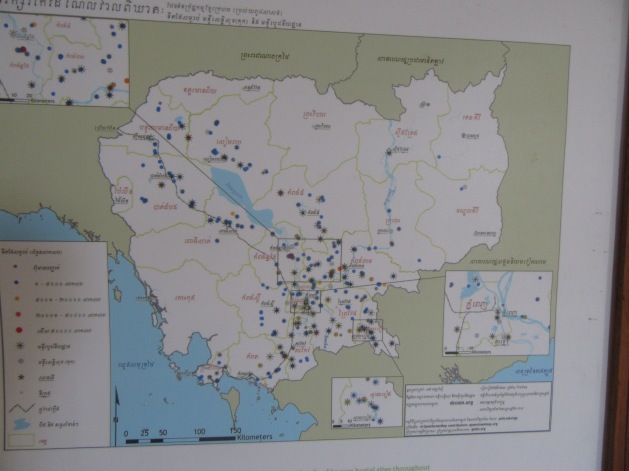
The museum was very difficult to go through because it is compact and the atrocities are in front of you immediately, and don’t let go the entire time.
Visiting The Killing Fields felt a little more diluted, if such a word is possible in this context. Spread out over several acres, it is easier to slow the pace and absorb what you are hearing in your audio set (same excellent set-up as at the museum).
Again, signs are posted asking people to be quiet, and almost everyone complies, lost in what they are hearing and seeing.
The tour began at the area where the trucks would arrive from S-21, full of beaten and terrified victims. Almost immediately, they would be executed, but because the Khmer Rouge did not want to pay for bullets, most of the victims were bludgeoned to death.
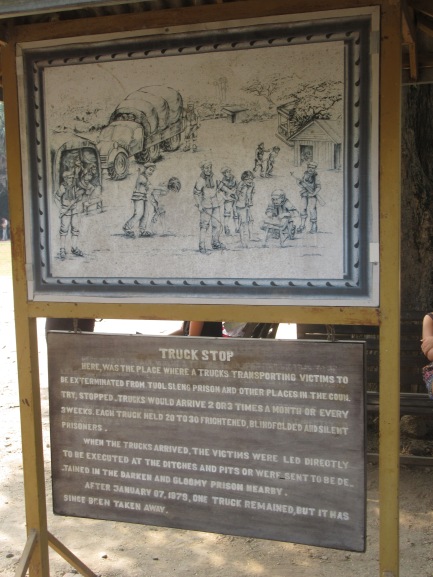
Their bodies were tossed into huge mass graves. The fields are filled with indentations like this; an indication of where each grave was, and how they have filled in again since their excavation. More than 8000 skulls were retrieved, as well as teeth, bones, and clothes. There is a display holding remnants of cloth that were salvaged. With each season, cloth and bone continues to emerge from the ground.
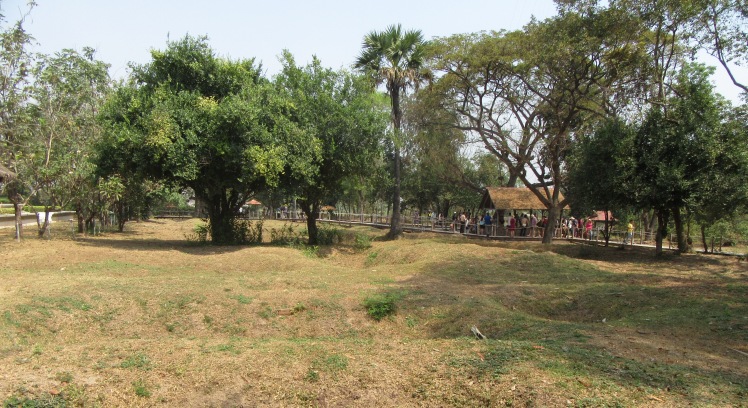
Mass graves that were more particular (women and children only, headless, etc.) are marked and covered, like the one below. Visitors have left thousands of bracelets as tokens of remembrance. Stephen removed one of his bracelets as well and left it behind.
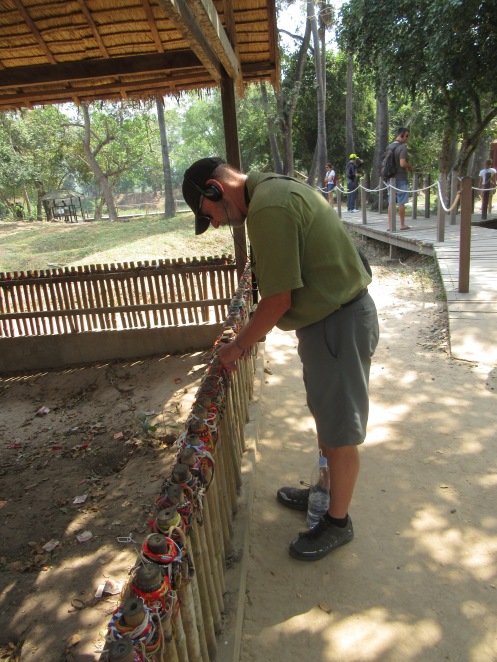
One of the sites that was the most difficult to bear was the “killing tree.” Babies and toddlers were murdered by being swung by their feet and having their tiny skulls bashed against the tree. Their bodies were then tossed into the pit behind.
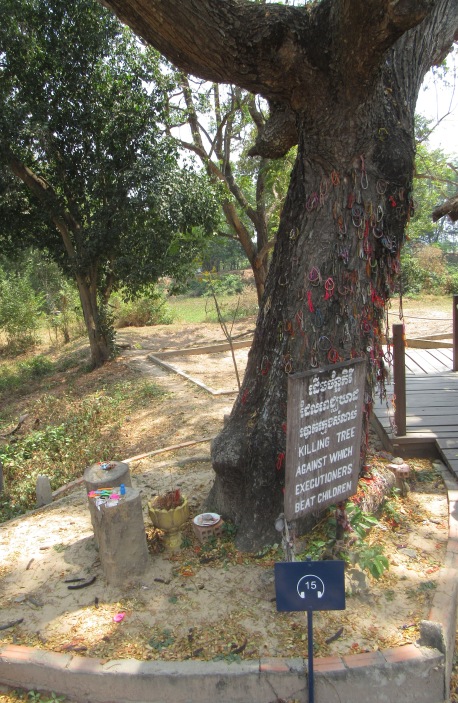
The following tree holds its own special horror. Victims were held in one area, while each execution took place and then moved when it was “their turn.” In order to mask the sounds of the victims screams, the cadres attached a loudspeaker to this tree and played music full blast.
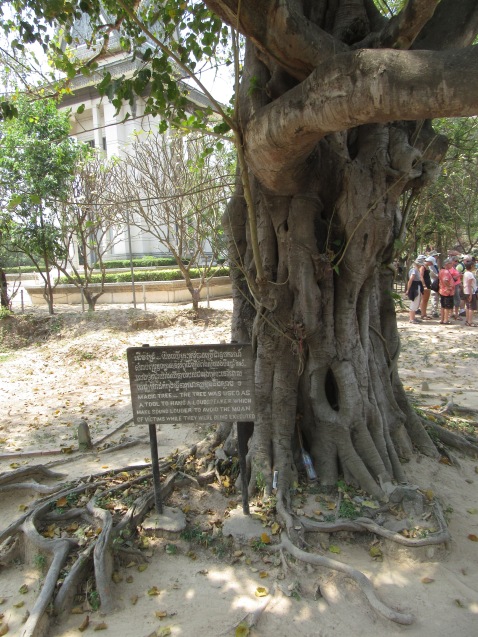
We ended the tour with a visit to the memorial stupa. This contains the skulls and remains of the more than 8000 victims.
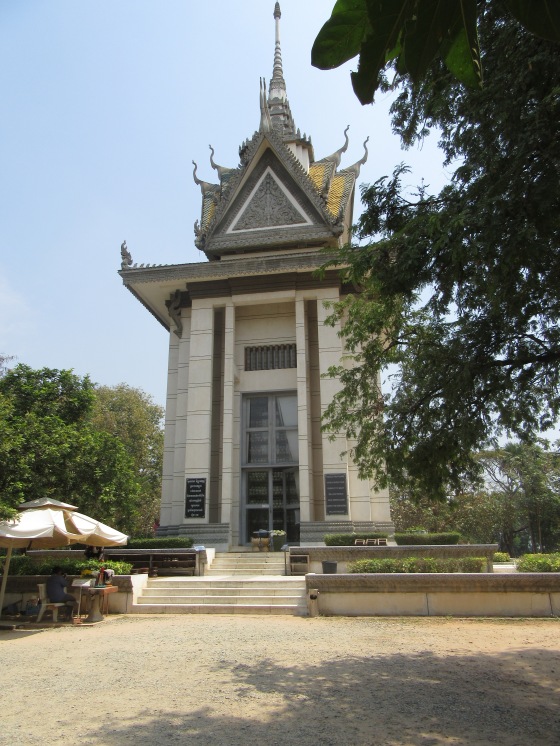
Murder weapons are displayed, followed by skulls and then bones. It is possible to tell how the victim died by looking at their skulls – pierced by a bayonet, clubbed with a wooden stick, or slashed with a knife or ax. Coloured dots on the skulls identity gender and method of murder, and the skulls are arranged according to estimated age.
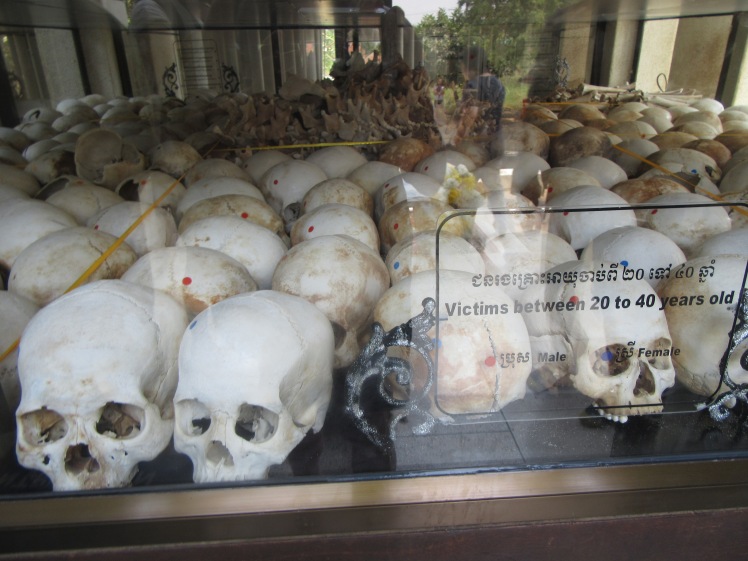
This sign to the side of the memorial stupa is a reflection of the intention of the museum and Killing Fields – a way to respect and honour the dead.

Atrocities are impossible to understand. Stephen and I spent a great deal of time trying to wrap our heads around such brutality. Evil paranoid people, given the right circumstances, can galvanize the masses. Xenophobia, looting, destroying works of art, denying religion – those are easy to figure out. But how do great numbers of people, no matter how oppressed and disenfranchised, inflict such suffering on innocent people, on children? What is their breaking point?
No answers. Both visits were difficult, but we are so glad we went and learned more about a piece of history we knew little about.
.
Peace, Ginny and Steve. Thank you for bearing witness.
love,
Shelagh
LikeLike
Thank you, Shelagh. Bearing witness is what you do for so many – all the more heartfelt appreciation to you.
LikeLike
I couldn’t hold back the tears reading this. God bless these victims.
LikeLike
And it isn’t over yet. The survivors are 50 years old and up, and their families have been affected by their trauma. And so on and so on.
There are so many NGOs and social enterprises in Cambodia doing so much for these people, so that is a ray of hope.
LikeLike
Ginny: Thank you for this too vivid account of a history that is very difficult to digest. I was unable to read through the entire post as I found I was too emotional. So glad to have seen this trough your eyes as I would not have been able to do so. Stay safe. xo
LikeLike
Thank you Patti. The words and images are very tough, but an integral part of Cambodian history and of who the Cambodians are today. I know how lucky I am on an intellectual level, but I had no idea.
LikeLike
Through my tears, I thank you for sharing your experience.
Love and peace to you both.
Donna x
LikeLike
Thank you, Donna. Thank you for being there to read it – it really means a lot to share everything with you all.
LikeLike
Hard to imagine that a Pol Pot could exist and allowed such atrocities!!
But people have to remember and the musea are there to remind them!!
reading this brought tears to my eyes!!!
Hugs
danielle
LikeLike
Danielle – you know the shocking thing was the Khmer Rouge continued on as a force, even after being driven out in 1979. Pol Pot lived in Phnom Penh in comfort, re-married and never answered for his crimes. It is suspected someone poisoned him when he was in his 70s, but still…
LikeLike
Hi Ginny & Stephen. A very sobering blog & another example of man’s inhumanity to man.
Though not as efficiently organized as the Nazi death camps, the intention was the same – mass
extermination. The Nazis were a lot more efficient in their methods – the end result was the same.
We never learn!!
LikeLike
Hi Dad – I remember as a child learning about the Holocaust and thinking (selfishly) how lucky I was that I didn’t have to go through that. We grew up in peacetime, but pre-Internet, didn’t fully grasp that the atrocities continued – different people, smaller scale, but they never stopped.
Looking at our world today is all the proof we need.
LikeLike
Hello Ginny,
we know already so much of the horrors of the Killing Fields and the Pol Pot genocides. I must be honest, I did not read your text, sorry.
I do hope that the rest of your visit will be infinitely more pleasant.
Take good care of each other, love, Lis
LikeLike
We did not know so much about Pol Pot other than the cloud of horror that surrounded his name.
Cambodia is still defined by that time, and is an essential part of visiting here. I’m sure Vietnam will be the same – the effects of the war will inform some of what we see there.
Don’t be sorry about not reading – it is not an easy read at all – that’s why I put the warning at the beginning.
Our travels throughout SEAsia have been many things – challenging, insightful, eye-opening, sad, depressing, enlightening, but pleasant? That’s not always possible, or even desirable.
More on the rest of Phnom Penh soon.
LikeLike
This kind of violence, especially toward children, is just incomprehensible, and yes, very difficult to read about. But I thank you for sharing your experiences with us. Please continue to share it all– the good, the bad and the ugly! I’ll keep reading. I wanted to note that a friend of mine wrote a non-fiction book called Evil Men that explores the whys (as much as one can explore them) of atrocities like these. Humankind is so very complicated.
LikeLike
Junita – is your friend James Dawes? I will read that book for sure – this has been a topic of conversation for so long. Some argue that under the right circumstances, we are all capable of such things – I refuse to believe that.
During our visit to the Museum, one of the audio accounts was from an Australian woman who is an expert on such matters (like your friend). She talked about how the Khmer Rouge cadres were indoctrinated. They were each given small tasks – one would take a photo, another would strip the clothing, etc., so by the time the interrogation took place, the victim’s identity was gone, and that enabled the interrogator to carry out their task.
You’re right – we are so complicated. Perhaps I behave the way I do because I have never had to fight for anything, so I lose nothing by being civilized.
LikeLike
I thank you for sharing the details of your visit, as disturbing as they are. I remember visiting the museum at Dachau in Germany when I was in my 20’s and some of the things I saw there remain with me still. There are many more questions than answers to the question, “why?” I guess it is up to each one of us to search for our own answers and to try to live our lives in accordance so these atrocities don’t repeat themselves generation after generation.
LikeLike
Heather, I guess you should take comfort that the things you saw at Dachau are still with you – it is a testament to your normalcy and sensitivity.
These are not the sort of events that any of us should easily put behind – we never want to be that desensitized.
We can look at memorials and monuments and read statistics, but they don’t always register. We move on. Sometimes it takes graphic images to illustrate the worst that people are capable of.
LikeLike